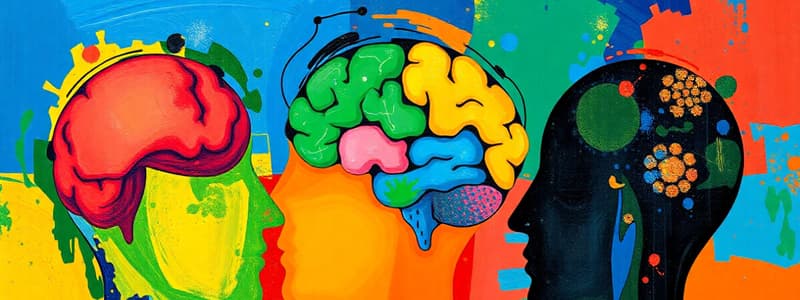Podcast
Questions and Answers
What is the primary focus of Human-Computer Interaction (HCI)?
What is the primary focus of Human-Computer Interaction (HCI)?
- To develop empirical understandings of users (correct)
- To make technology as complex as possible
- To minimize user involvement in technological design
- To create machines that function without user input
How is HCI related to User Experience (UX) design?
How is HCI related to User Experience (UX) design?
- HCI and UX design are completely separate fields
- HCI is considered the predecessor to UX design (correct)
- HCI is a subset of UX design
- UX design is considered the predecessor to HCI
Which of the following technologies has HCI contributed to developing?
Which of the following technologies has HCI contributed to developing?
- Photographic film
- Virtual reality (correct)
- Mechanical clocks
- Manual typewriters
What does Daniela Rus believe about the future of HCI?
What does Daniela Rus believe about the future of HCI?
In terms of technology interaction, what critical aspect does HCI address?
In terms of technology interaction, what critical aspect does HCI address?
What perspective does Daniel Jackson have regarding user interaction design?
What perspective does Daniel Jackson have regarding user interaction design?
What primary function do Dexta haptic gloves serve in a virtual reality environment?
What primary function do Dexta haptic gloves serve in a virtual reality environment?
Which of the following is NOT an example of technology influenced by HCI?
Which of the following is NOT an example of technology influenced by HCI?
What future advancements does the field of HCI potentially promise?
What future advancements does the field of HCI potentially promise?
How does pre-touch sensing technology aim to improve user interaction with smartphones?
How does pre-touch sensing technology aim to improve user interaction with smartphones?
What innovative capability does PaperID technology offer?
What innovative capability does PaperID technology offer?
What is the primary role of ganglion cells in the visual system?
What is the primary role of ganglion cells in the visual system?
Which aspect of visual perception refers to how much of a view an object occupies in relation to distance from the eye?
Which aspect of visual perception refers to how much of a view an object occupies in relation to distance from the eye?
What are the two primary stages of vision as described in the content?
What are the two primary stages of vision as described in the content?
What influences human capabilities as mentioned in the context of information processing?
What influences human capabilities as mentioned in the context of information processing?
What is the significance of visual acuity in human vision?
What is the significance of visual acuity in human vision?
What is the primary difference between deductive and inductive reasoning?
What is the primary difference between deductive and inductive reasoning?
Which of the following best describes the phenomenon of chunking in skill acquisition?
Which of the following best describes the phenomenon of chunking in skill acquisition?
Which theory posits that emotion originates from our interpretation of physiological responses?
Which theory posits that emotion originates from our interpretation of physiological responses?
What type of reasoning involves deriving potential causes from observed events?
What type of reasoning involves deriving potential causes from observed events?
How does positive affect influence problem-solving according to the provided information?
How does positive affect influence problem-solving according to the provided information?
In the context of errors, how do 'slips' differ from 'mistakes'?
In the context of errors, how do 'slips' differ from 'mistakes'?
What does the problem space theory suggest regarding problem-solving?
What does the problem space theory suggest regarding problem-solving?
Which statement accurately describes negative affect in relation to task performance?
Which statement accurately describes negative affect in relation to task performance?
Which type of memory acts as a buffer for stimuli received through senses?
Which type of memory acts as a buffer for stimuli received through senses?
What is the average reaction time for auditory stimuli?
What is the average reaction time for auditory stimuli?
Which of the following is NOT a type of long-term memory?
Which of the following is NOT a type of long-term memory?
What supports inference in semantic memory structures?
What supports inference in semantic memory structures?
Which of the following best describes proactive inhibition?
Which of the following best describes proactive inhibition?
Which model organizes information into data structures featuring slots instantiated with values?
Which model organizes information into data structures featuring slots instantiated with values?
What effect is created by spreading learning over time?
What effect is created by spreading learning over time?
What is the main role of rehearsal in the memory process?
What is the main role of rehearsal in the memory process?
What does size constancy refer to?
What does size constancy refer to?
What are the three components that make up color?
What are the three components that make up color?
Which component of the auditory system is responsible for protecting and amplifying sound?
Which component of the auditory system is responsible for protecting and amplifying sound?
How does the visual system compensate for ambiguity?
How does the visual system compensate for ambiguity?
What types of receptors are involved in haptic perception?
What types of receptors are involved in haptic perception?
Which of the following statements accurately describes saccades?
Which of the following statements accurately describes saccades?
What is the primary role of the inner ear in the auditory system?
What is the primary role of the inner ear in the auditory system?
What is the primary focus of pragmatics in language interpretation?
What is the primary focus of pragmatics in language interpretation?
Flashcards are hidden until you start studying
Study Notes
Recognition
- Information gives knowledge of past encounters.
- It is less complex than processed information.
Reasoning
- Deductive reasoning: Derives logical conclusions from given premises, involves logical and rational thinking. It can be challenged when truth and logical validity clash.
- Inductive reasoning: Generalizes from observed cases to unobserved cases, involving assumptions that may or may not be accurate.
- Abductive reasoning: Reasons from an event to its cause, potentially leading to false explanations.
Problem-Solving
- Process of finding solutions to unfamiliar tasks using existing knowledge.
- Gestalt theory: Problem-solving involves both productive and reproductive processes, but lacks sufficient evidence to fully explain insight.
- Problem space theory: Problem-solving involves generating states using legal operators within the human information processing system.
Skill Acquisition
- Skilled activity is characterized by chunking, allowing for:
- Conceptual grouping of problems rather than superficial grouping.
- More effective information structuring.
Errors
- Slips: Incorrect execution of a correct intention, caused by poor physical skills.
- Mistakes: Incorrect intention based on misinterpretation, caused by incorrect understanding.
Emotion
- Emotion involves both cognitive and physical responses to stimuli.
- Affect: Biological response to physical stimuli, influencing reactions to situations.
- Positive affect: Promotes creative problem-solving.
- Negative affect: Can narrow thinking and hinder task performance, even for simple tasks.
- Theories of emotion:
- James-Lange: Emotion arises from physiological responses to stimuli.
- Cannon: Emotion is a physiological response to stimuli.
- Schacter-Singer: Emotion results from evaluating physiological responses within the context of the situation.
Foundations of Human-Computer Interaction (HCI)
- HCI focuses on designing computers and machines that best serve human users.
- It is closely related to User Experience (UX) design and is considered its predecessor.
Why HCI Matters
- HCI aims to improve the user experience by enabling better computer and machine interactions.
- It has contributed to significant inventions like virtual reality, self-driving cars, and touch screen technologies.
The Future of HCI
- Dexta haptic gloves: Mimic touch sensations in virtual reality by locking and unlocking finger joints.
- Pre-touch sensing: Uses smartphones to predict user actions based on grip and finger position.
- PaperID: Aims to digitize paper by making it a touchscreen, responding to gestures and connecting to the internet of things.
The Human
- Information input/output: Visual, auditory, haptic, movement
- Information stored in memory: Sensory, short-term, long-term
- Information processed and applied: Reasoning, problem-solving, skill, error
- Emotion: Influences human capabilities and abilities.
Vision
- Two stages:
- Physical reception and function of stimuli.
- Processing and interpretation of stimuli.
The Eye
- Physical reception mechanism: Receives light and converts it into electrical energy.
- Light from objects reflects into the eye.
- Retina contains rods (low-light vision) and cones (color vision).
- Ganglion cells collect visual information and detect patterns and movement.
Interpreting the Signal
- Visual system compensates for:
- Movement
- Changes in luminance
- Context is used to resolve ambiguity.
- Optical illusions can occur due to overcompression.
Size and Depth
- Visual angle: Defines how much of the view an object occupies, influenced by size and distance.
- Visual acuity: Sharpness, ability to perceive detail, which is limited.
- Size Constancy: Familiar objects are perceived as constant size, despite changes in visual angle when far away.
Brightness
- Subjective reaction to light levels.
- Influenced by luminance (light intensity).
- Visual acuity and flicker increase with luminance.
Color
- Composed of hue, intensity, and saturation.
- Hue: Color and shade.
- Intensity: Purity of a hue.
- Saturation: Dominance of hue in the color.
- Colorblindness: Affects 8% of males and 1% of females.
Auditory: Hearing
- Provides information about the environment.
- Physical apparatus:
- Outer ear: Protects inner ear and amplifies sound.
- Middle ear: Transmits sound waves as vibrations to the inner ear.
- Inner ear: Releases chemical transmitters, causing impulses in the auditory nerve.
Auditory: Hearing - Sound
- Pitch: Sound frequency.
- Loudness: Amplitude.
- Timbre: Type or quality.
- Humans hear frequencies from 20Hz to 15KHz.
- The auditory system filters sounds and can focus on specific sounds over background noise.
Haptic: Touch
- Provides feedback about the environment, especially crucial for visually impaired individuals.
- Receptors in the skin:
- Thermoreceptors: Detect heat and cold.
- Nociceptors: Detect pain.
- Mechanoreceptors: Detect pressure or tension.
Movement
- Reaction Time: Time taken to respond to a stimulus, including:
- Reaction Time: Time to initiate a response.
- Movement Time: Time to complete the movement.
- Factors influencing Movement Time: Age, fitness, etc.
- Factors influencing Reaction Time: Stimulus type.
- Visual: 200ms.
- Auditory: 150ms.
- Pain: 700ms.
Sensory Memory
- Also known as working memory.
- Buffers for stimuli received through senses:
- Iconic Memory: Visual stimuli.
- Echoic Memory: Aural stimuli.
- Haptic Memory: Tactile memory.
Short-Term Memory
- Temporary storage for recall.
- Fast access: 70ms.
- Rapid decay: 200ms
Long-Term Memory
- Repository for all knowledge with:
- Slow access.
- Slow decay.
- Large, potentially unlimited capacity.
Long-Term Memory Types
- Two types:
- Episodic: Serial memory of events.
- Semantic: Structured memory of facts, concepts, and skills.
Semantic Memory Structure
- Provides access to information.
- Represents relationships between information.
- Supports inference.
Semantic Network Model
- Inheritance: Child nodes inherit properties of parent nodes.
- Explicit and Precise: Relationships between information are explicitly and precisely defined.
- Supports inference through inheritance.
Models of Long-Term Memory
- Frames: Information organized in data structures with slots and values.
- Scripts: Models for stereotypical information needed to interpret situations, with elements that can be instantiated with contextual values.
- Production Rules: Represents procedural knowledge using condition/action rules: "If [condition] is met, then [action]."
LTM: Storage of Information
- Rehearsal: Moves information from STM to LTM.
- Total Time Hypothesis: Amount retained is proportional to rehearsal time, but learning can be optimized by spreading practice over time.
LTM: Forgetting
- Decay: Information is gradually lost over time.
- Interference:
- Retroactive: New information replaces old.
- Proactive: Older information interferes with new.
LTM: Retrieval
- Recall: Reproducing information from memory, which can be aided by cues like categories or imagery.
Studying That Suits You
Use AI to generate personalized quizzes and flashcards to suit your learning preferences.




